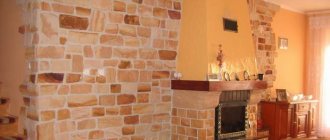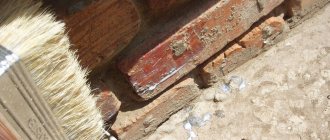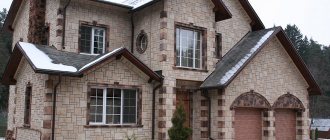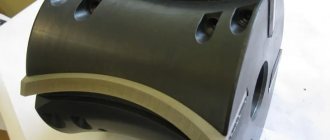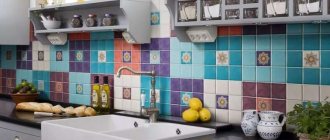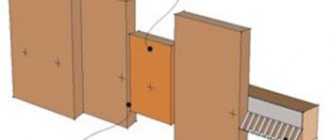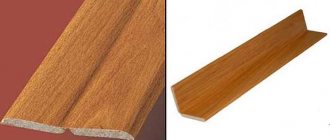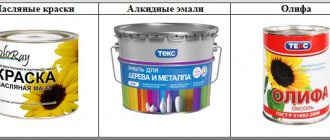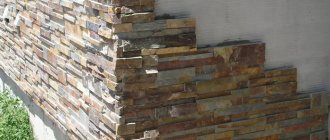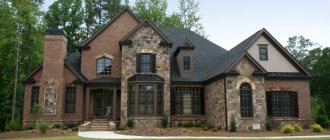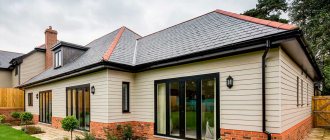Paving stones – Tile – Border
Natural stone is considered the best material for cladding facades not only from an aesthetic, but also from a practical point of view. This applies to both operational qualities and technical characteristics, and a purely aesthetic component.
For any building - no matter whether it is a residential building or a good business center, attractiveness and beauty are very important. These qualities give significance and respect to the office, and in a beautifully decorated country house the family feels much cozier and more comfortable. Finishing facades with natural stone additionally allows you to achieve maximum aesthetic performance.
Facing the base with granite not only gives it an impeccable appearance, but also protects it well from adverse environmental factors. In terms of its qualities, granite is in many ways superior to other materials that are more affordable. Therefore, the owner of the building must choose a finishing material, focusing on its performance characteristics, and only after that pay attention to the price.
Finishing facades with natural stone is quite popular due to the unique properties of this material:
- enviable aesthetic indicators; strength; resistance to external factors; insensitivity to ultraviolet - cladding the base with granite guarantees a long service life; durability - the facade lasts for many decades; the widest range of colors, an abundance of original textures; environmental friendliness and so on.
At the same time, one should not ignore the fact that natural stone is an expensive material, and if economic requirements come to the fore, then it is better to immediately choose another, more affordable material. In addition, the significant weight of such a facade means the need for more powerful foundations, which further increases the cost of construction.
However, these two disadvantages begin to seem insignificant if we consider them not in isolation, but in conjunction with the undoubted advantages and benefits of this unique material. This is why finishing facades with natural stone is so popular among owners of buildings for various purposes.
Types of finishing stone
To perform finishing work, limestone, sandstone and slate, mined in open-pit mines, are most often used.
But the clear leader among all types of natural stone used in finishing work in terms of its technical characteristics is granite. Finishing the facade with granite makes it possible to obtain unique results. This stone has significant advantages over others:
- richness and variety of types and colors - black and gray are very appropriate for finishing facades, but quite rare colors are also found in nature, including green, rose-red and yellow; the presence of original “spotting” caused by feldspar inclusions; ease of maintenance - ventilated granite facade is easy to wash and clean from dirt; high heat capacity; good sound insulation qualities; immunity to large temperature changes; fire resistance; environmental friendliness; durability; high strength; moisture resistance.
These qualities, as well as many others, are the reason why façade finishing with granite is in many cases the most preferred option for building design.
Price for facades and plinth made of granite
There are several known methods for finishing facades with granite. The most common is gluing granite tiles to the prepared surface. For this purpose, special adhesive mixtures are used.
The price of a granite facade is quite high, which is determined by the solid cost of the natural material. But even here you can choose more economical options, focusing on color.
The cheapest granite is gray. But this type of stone is the least durable. Although this does not prevent it from being used for finishing most often.
Traditionally, the most valuable material is the one with rich shades of black and red. Entrance groups made of granite of this type look very presentable and do not lose their appearance for a long time. That is why entrance groups made of granite are very often made in country mansions, banks and office buildings.
Finishing the base with natural stone is extremely popular among owners of country houses and cottages. Due to the small area of the plinth, which amounts to 1/5 of the entire area of the facade of any house, facing the plinth with stone is quite affordable for most homeowners.
Types of stone
Rough stone
Rough stone is stone of various sizes and shapes, mined in the form of sheets, cobblestones or pebbles. The use of raw stone when finishing the base allows you to create surfaces with truly original texture, pattern and color.
Processed stone
Processed stone is divided into the following main types:
- tiles - made by cutting stone, of arbitrary length and fixed height, as well as with or without pinning around the perimeter of the tile; there is directly such a subtype as finishing the base with tiles, but this, often, will not be stone; “noodles” or “ hump” - produced by cutting along the outer edge of a flat stone, one side is sawn, 3 - natural; tumbled stone - produced using a tumbling machine, rounding the sharp edges of both sawn and unsawn stone; strip - produced by cutting flat stone into strips of a given width of 35-50 mm.
Treated stone can be made from any type of stone. In addition, factory processing of stone can significantly simplify its installation.
Mainly used for finishing the base:
- shungite; marble; sandstone; limestone; dolomite; siltstone; lemezite; slate; quartzite sandstone; wild stone; goldstone; granite.
Other types of stone can also be used.
Stone-look façade plinth panels: what is it?
Stone-look façade plinth panels are facing elements that perform a protective function: they protect the plinth from the negative influences of the environment. In addition, panels of this type play a key role in the aesthetic appearance of the building. Today, the market offers many options that differ in composition, color, structure and other characteristics that interest the buyer.
Dimensions
The dimensions of the panels depend on many factors, including the material, manufacturer and dimensions of the base.
As a rule, the average parameters of slabs for finishing the foundation of a house look like this:
- plastic: length: 3,000 – 3,750 mm;
- width: 220 – 275 mm;
- thickness: 0.6 – 1.3 mm.
- length: 700 – 3,200 mm;
- length: 450 – 3,600 mm;
- length: 400 – 600 mm;
- length: 800 – 1,260 mm;
Photos of houses
An option for facing with basement siding imitating natural rubble stone is presented below. As you can see, the color of the base is perfectly matched to the shade of the brown windows.
An example of facing panels for the exterior finishing of a basement, imitating brick, is shown in the following picture.
As an example, the photo below shows a variant of cladding the base under ashlar.
Advantages of finishing the plinth with natural stone
The service life of a plinth finished with natural stone, provided that all installation rules are followed, exceeds the service life of a plinth made of any other finishing material. Natural stone requires virtually no maintenance. It absolutely does not absorb or transmit moisture and has very low thermal conductivity, frost resistance and high environmental friendliness.
Many types of natural stone undergo additional heat treatment, which further improves their performance qualities, such as strength and resistance to the external environment. After installation is completed, the finished surface of the natural stone plinth is varnished or treated with a special solution.
This avoids natural changes in the facial structure of the stone, such as:
- the appearance of efflorescence; the appearance of mold; the appearance of moss.
No further processing is required in the future. The exception is washing the base, which is performed only in the case of washing or repairing the facade.
Another advantage of natural stone is its exceptional compatibility with any type of materials used for finishing facades and creating landscape design.
Summarizing
During operation, the base of the house inevitably becomes covered with dirt and dust. It's easy to care for. Simply rinse the base with a stream of water and it will return to its original appearance.
It is also necessary to mention the protection of the cladding, since for natural stone moisture that penetrates into the cracks between the cladding elements is dangerous. In addition to the fact that it can cause mold and moss, it can cause the cladding to peel off. To prevent this from happening, it is recommended to varnish the cladding and make a canopy over the base that will protect the finish from moisture penetrating into it.
- Benefits of Lemesite
- Advantages of marble chips
- Stone mosaic
Cost of natural stone
There is an opinion that finishing the base with natural stone is the most expensive type of finishing, mainly due to the high cost of the stone itself. But by looking at the different types of stone and their costs, you can easily see that this is not the case.
Of course, lining the base with expensive marble, granite or other rare types of stones requires a significant amount of money. However, it is possible to clad the base with natural stone with a much smaller budget by choosing a less expensive type of stone, for example, flagstone, sandstone, rubble, limestone and others.
At the same time, the appearance of the base will not suffer at all, because the color range of any type of stone is very diverse. This makes it easy to select the stone of the required shade according to your design project.
The surface of the base needs additional protection from moisture and adverse weather conditions, especially in the off-season. The porous structure of the building material is subject to temporary destruction due to the penetration of water inside.
As a result of freezing, the ice expands and, as a result, damage occurs. To create a protective layer, various methods are used, one of which is stone cladding. When choosing a finishing material, you should take into account not only its decorative qualities, but also properties that will help prevent premature destruction of the base of the building.
Using clinker tiles
The lower part of the facade, finished in this way, is very similar to a wall made of ordinary clinker bricks. The surface of the tile can be smooth or torn (decorative).
The advantage of this type is its lightness and small thickness (hence the absence of the need for a separate foundation), as well as the possibility of attaching corner parts.
In addition, clinker tiles are one of the most aesthetic finishing options.
Next, we will consider the process of cladding the base with our own hands step by step:
- Preparatory operations, applying an adhesive layer about 5 mm thick (it is recommended to use frost-resistant glue). The adhesive must be applied to both the base and the tiles. You should not cover a large surface area with the adhesive solution - it dries quite quickly.
- Determining the initial level, taking into account the height of the plinth, the width of the tiles and the size of the joints.
- Fastening the facing material to the wall. It should be remembered that the tiles are laid in a horizontal row, and the vertical seams should not coincide. You need to start from the outer corner of the wall. Upon completion of work, further work should be postponed for several days until completely dry.
- The seams of the tiles are filled with special frost-resistant compounds.
Watch the video on how to finish a base with stone
In the old days, the outside of the foundation was finished with plaster.
Nowadays the method is used less and less due to the short preservation of the original appearance. Exposure to moisture and temperature changes are the main reasons for the delamination of the plaster layer; it only lasts for 3-5 years. Periodically, the surface should be restored, repairing exfoliated fragments. Another thing is modern technologies and materials, which make it possible to carry out finishing work much less frequently. The properties of natural stones provide reliable protection for the foundation, extending its service life.
Advantages of facing the base with stone
excellent performance characteristics;
provides reliable protection from external factors;
high resistance to temperature fluctuations, frost resistance;
the stone protects from moisture and fire;
easy care;
presentable appearance;
durability.
The market for facing materials is presented in a wide range, which is divided into natural minerals and artificial stones. Both options deserve attention, but natural raw materials must have frost-resistant properties and strength, which are sufficiently available in the artificial analogue. There will be no problems with the selection of tonality and texture. You can find examples of marble, slate, granite and other rocks.
Disadvantages of facing the base with stone
Artificial stones have the appropriate technical characteristics for finishing the foundation, but products from the cheap segment do not have sufficient strength. Yes, some difficulties may arise during installation. Therefore, it is worth choosing high-quality cladding that fully meets the functional requirements.
If the choice fell on a natural mineral, then you should be prepared for difficulties during installation. In addition, most likely, you will have to carefully prepare the surface beforehand.
The main mistakes made when purchasing a stone. Incomplete knowledge causes the choice of a fragile material, endowed with hygroscopicity and low density. These factors provoke premature destruction of the structure, and as a result, replacement of the cladding.
Finishing features
An important part of the structure is the base, which must meet aesthetic and functional requirements. To ensure that the finish does not fall off over time, special attention is paid to work on the foundation.
- Due to atmospheric influences and moisture (rain, snow, ice), the base is susceptible to damage. Finishing the area has a protective function. It is necessary to choose a material that will protect the foundation and walls of the building from dampness and gradual destruction.
- During the process of shrinkage of the building, all kinds of movements that occur under various circumstances, the finishing material of the base experiences loads of varying degrees. Artificial stone is resistant to mechanical stress. Retains its original condition under moderate mechanical influence.
- When the weather changes in the autumn-spring period, the external cladding of the house undergoes the detrimental effect of a sharp temperature change. If the material does not meet the required performance characteristics, it will quickly lose its strength properties and destruction will begin.
- When purchasing artificial stone, owners count on the durability and reliability of the finishing material. A quality product lives up to expectations.
- A harmonious combination of all finishing elements is necessary. The material helps create an attractive appearance of the facade.
Types of natural stones
Granite is the most common option for finishing the base among other rocks. The material is produced in the form of tiles with a thickness of 1 cm or in stone blocks of different tones. The cut is distinguished by an original pattern, which gives the structure high cost and sophistication.
Sandstone is also popular in finishing work. The color range is limited to one tone, in contrast to the sizes, which are presented in a wide range. The structure of the stone is not strong enough, so it is used mainly as cladding.
Surface preparation
Before finishing, the base must be primed.
Before the cladding begins, the facade is prepared. The base is cleaned of dust, dirt, and deposits. Next comes priming the surface. If the box was erected recently, you need to give it time to shrink. After priming, a reinforcing mesh is fixed to the surface. Fix the stone on the concrete foundation and on the frame. To fix the elements on the insulation, dowels are used.
When using heavy fragments, a metal frame is pre-arranged. All irregularities on the base must be eliminated and the surface must be completely dry.
Stages of plinth cladding with natural stone
The foundation above the ground is most often built from fire-resistant red brick, which is characterized by high strength. It can easily withstand heavy loads. If other materials were used to form the base, the structure will need to be pre-strengthened.
The working surface must be smooth and intact (without gaps or cracks). In this case, additional leveling with concrete mortar will not be necessary. When performing concreting, reinforcing mesh should be laid.
The stone is secured to the base surface using a concrete solution. It is irrational to use adhesive mixtures. Concrete is distributed over the work area, covering small areas to secure several elements at once. The solution is not applied to the back side of the rock.
To adjust the dimensions of the material, it is recommended to use a tile cutter or diamond wheels. Cutting work should be carried out wearing safety glasses to prevent eye injury.
The concrete mixture has a grayish tint that will be visible through the seams. If the tone does not match the main color of the stone, it is recommended to add pigment to the solution.
Technologies for installing basement cladding
There are many types of artificial stone for plinth cladding. There are also several ways to install them, which directly depend on the products purchased:
- "Wet" method. It consists of applying an adhesive composition to the base for subsequent fastening of the facing slab product. This is a cheaper and more popular way to level the base. This is what we will look at below.
- The “dry” method involves lining the foundation with artificial stone on a pre-installed sheathing of wooden or metal slats.
“Wet” method of plinth cladding
If you purchased “flexible” stone, clinker tiles or products based on concrete and polymer concrete, for high-quality finishing you will need to prepare the base, namely stretch it with a concrete screed or cover it with moisture-resistant sheets.
When carrying out any facade work, it is worth remembering that they can only be carried out at an ambient temperature of at least +5C0 and with an average humidity of 75%.
Leveling a concrete plinth
The traditional way to level the base for cladding is to use a concrete screed of the required layer. To do this you will need:
- sealant;
- primer;
- lighthouses;
- profiles;
- quick-hardening adhesive solution;
- tape measure, building level;
- spatulas;
- rule;
- concrete solution in a ratio of 1:3.
Stage 1. The wall is thoroughly cleaned of dust and old plaster. Check for cracks. If there are any, they must be sealed with sealant. To increase adhesion, you need to apply several layers of primer.
Stage 2. After the wall has completely dried, using the building level as a guide, you need to fix the beacons at a distance of half a meter from each other. To make the work go faster, you can “plant” the profiles in an “express drying” solution.
Stage 3. After the adhesive has dried, you can pour the concrete solution so that it is approximately 1 cm higher than the beacons.
Stage 4. As a rule, slowly lift it with smooth movements with shifts to the sides, so that the solution takes on a flat surface, at the same level as the beacons. Happened? Level the wall to the end.
Stage 5. After the solution has completely hardened - after about 3-4 weeks, depending on the layer of the solution, you need to apply a deep-action primer. After it hardens, you can proceed to facade finishing work.
Preparing a wooden base
But if you need to finish a wooden house, then you will need to act differently.
Stage 1. Clean the surface and repair flaws if necessary.
Stage 2. Cover the base with roofing felt to the required height and secure it.
Stage 3. To increase adhesion, it is necessary to install a plaster mesh with an anti-corrosion coating on the waterproofing and cover it with plaster mortar. After it dries, you can finish the base.
Preparing a brick plinth
For a brick base, no special preparation is required, unless, of course, there is significant damage to the brickwork that will need to be puttied. Afterwards, treatment is carried out with a special solution, which will eliminate efflorescence and prevent its release, and also increase the adhesion of the tiles to the wall. Afterwards we prime and dry the wall.
